Note that by 'copied', I'm not talking about anything that's lawsuit-worthy - oversampling had been done before the Nokia 808, just not in a phone camera. Sony's implementation involves a 1/2.3" 20MP sensor (c.f. 1/1.5" 41MP on the Lumia 1020), so well under half the sensor size and around half the raw resolution. The core idea's the same though - output images are at an oversampled 8MP by default, with lossless zoom up to around 1.8x
How well does Sony's version of the technology work? That's what we're here to find out, though physics usually dictates the overall result in tests of this kind and the 1020's far larger sensor meaning roughly three times more practical light gathering ability. In most light conditions, of course, the limiting factors are optics and image processing, but in low light the Z1 will struggle and it's capabilities aren't helped by the weedy LED flash being outgunned by the Xenon bulb in the Lumia 1020.

On with the tests, though. Some notes:
- The output resolutions of the two phone cameras are different (5MP versus 8MP), plus they have different fields of view, so it's not possible to match the shots/crops exactly (or do one of our famous interactive comparators).
- All settings were on auto, except where noted below.
- The Z1 was on the August 8th OS kernel, with firmware build 14.1.6.1.518 - my initial tests with it showed a marked difference between 'auto' mode results and 'manual', but after a round of app updates and a reboot the phone settled down and there were marginal differences between the two modes. Sony is expected to tweak 'auto' mode in an upcoming firmware update, but the modes can be discounted for these tests. In the one or two cases where the 'auto' photo looked worse, I switched in the 'manual' one instead. I initially planned to show both here, but they were in most cases so similar that casual readers wouldn't be able to spot differences and would have got confused.
- On the Lumia 1020, I used Nokia Pro Camera to take the shots, for maximum oversampling benefit. Note that, as per my recent exclusive editorial, I only used the initial 5MP photos, so that quality wasn't lost, i.e. there was no 'reframing' at any stage.
- In each case, I've included the original JPG files, in case you want to take the time to download them and examine them for yourself.
- Just for fun, I've scored the results as I've gone along. Ten test scenes, ten points available for each. See the verdict at the end for a final summation.
__________
Test 1: Sunny scene
A sunny day, perfect for testing smartphone cameras when there's loads of light. No real need for oversampling here, so this is more a test of optics. This is the typical 'normob' snap. No PureView zoom, just take the shot and see how it comes out. Here's the full scene:
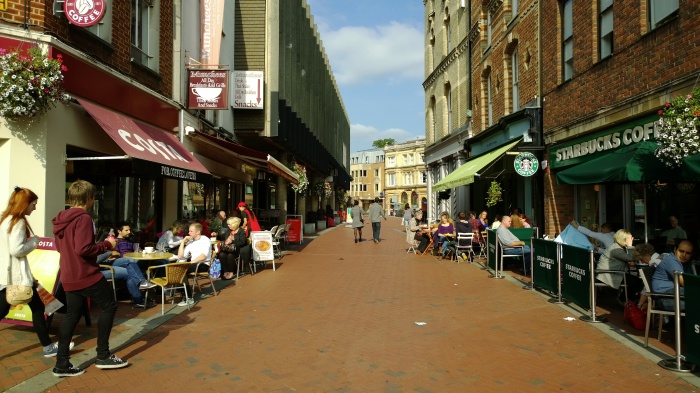
Original images from the Lumia 1020 and Xperia Z1
As ever, let's crop in to central detail to see the sort of quality being delivered by each camera phone. The Lumia 1020 crop is on the left, the Z1 on the right:
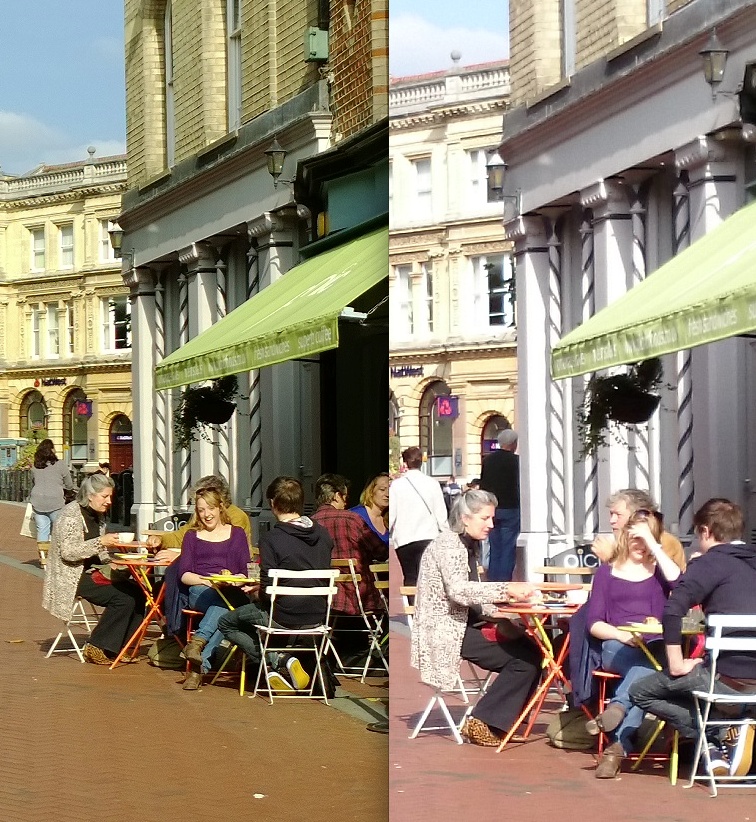
The Z1 does well here, but the building detail and other bright highlights are 'blown out', while the Lumia 1020 captures astonishing detail and colour, especially considering that its photo above is at lower resolution than the Z1's.
Purely out of interest, I did try reframing the Lumia 1020 shot, to explore the potential detail captured. Look at the scene overview above and then look at this shot:

It's certainly not pixel perfect, but is still very impressive considering that the people in the shot were incidental to the scene and were around 30 metres away.
Overall then, based just on the default 5MP/8MP outputs, there were better colours and detail in the Nokia's photo. Score: Lumia 1020: 10 pts; Xperia Z1: 8 pts
__________
Test 2: Bright overcast, full (lossless) zoom
Time to put the facility to zoom to the test, 2.5x in the Lumia 1020's case (for 5MP output) and 1.8x in the Z1's case (for 8MP output), in this case trying to get optically closer to the goose (without scaring it or getting my feet wet!) Here's the full scene:

Original images from the Lumia 1020 and Xperia Z1
As ever, let's crop in to central detail to see the sort of quality being delivered by each camera phone. The Lumia 1020 crop is on the left, the Z1 on the right:

Both shots look a little 'processed', as you might expect given that both phone cameras are down to 1:1 pixel use on their sensors. The Lumia's photo has characteristic noise from over-sharpening, the Z1's has characteristic blurring from noise reduction, but I'd give the win to the Z1 here. Its photo looks more natural and the 1020's noise patterns are very offputting.
Score: Lumia 1020: 7 pts; Xperia Z1: 8 pts
__________
Test 3: Bright overcast, shady park scene
Lovely rich Autumn colours and detail to render. Here's the full scene:

Original images from the Lumia 1020 and Xperia Z1
As ever, let's crop in to central detail to see the sort of quality being delivered by each camera phone. The Lumia 1020 crop is on the left, the Z1 on the right:

In each case I was focussing on the bench (and then reframing the scene slightly in the viewfinder), so the bench looks OK in both photos (though slightly cleaner and crisper in the 1020's version). But I'd draw your attention to the small blue flowers behind. In the 1020's version they're just recognisable, while the Z1's aggressive noise reduction and sharpening has reduced most of the flowers to tiny streaks of colour. Also, the piles of leaves look to be full of artefacts and generally unpleasant.
Score: Lumia 1020: 8 pts; Xperia Z1: 6 pts
__________
Test 4: Sunny zoomed detail
I couldn't resist this rooftop clock and sculptings, using full lossless zoom on each camera phone, even though I had to add a 'stop' to the exposure in each case (on the Z1, achieved by switching to 'Manual' mode). Here's the full scene:
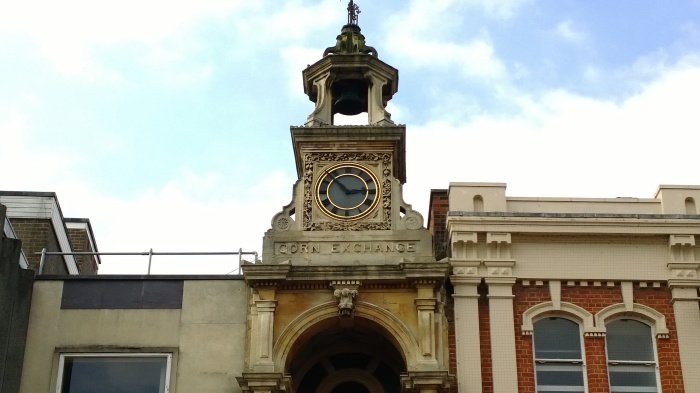
Original images from the Lumia 1020 and Xperia Z1
As ever, let's crop in to central detail to see the sort of quality being delivered by each camera phone. The Lumia 1020 crop is on the left, the Z1 on the right:
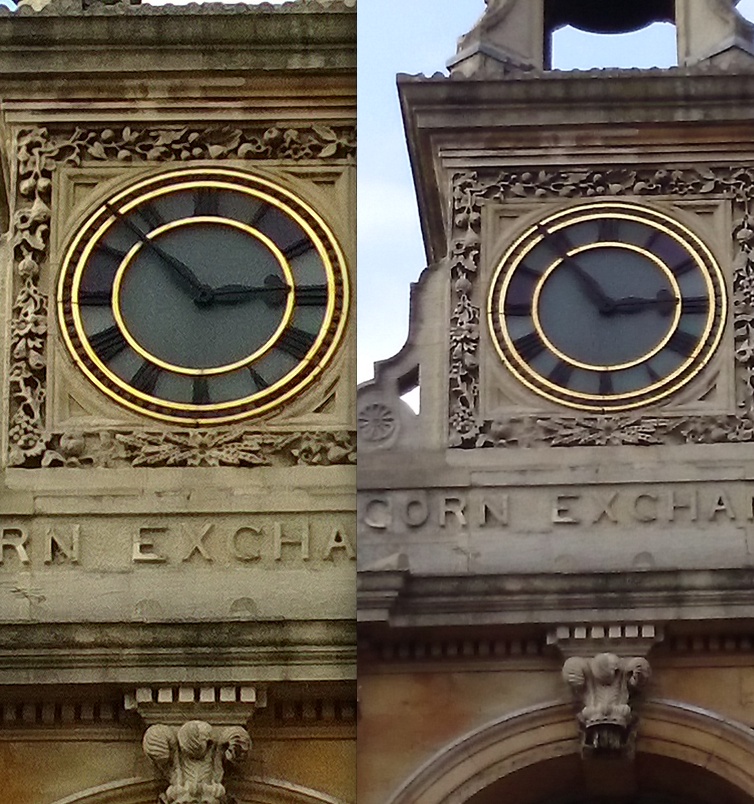
It's tough to call a winner here, since the Lumia 1020's photo has more detail, thanks to the greater zoom capability, but the Z1 shot has less rendered noise and more accurate colouration.
Score: Lumia 1020: 7 pts; Xperia Z1: 7 pts
__________
Test 5: Bright overcast, flower macro
As usual with the Nokia PureView devices, the minimum focussing distance isn't close enough, so I had to use a little PureView zoom to compensate (around 30%). Here's the full scene:

Original images from the Lumia 1020 and Xperia Z1
As ever, let's crop in to central detail to see the sort of quality being delivered by each camera phone. The Lumia 1020 crop is on the left, the Z1 on the right:
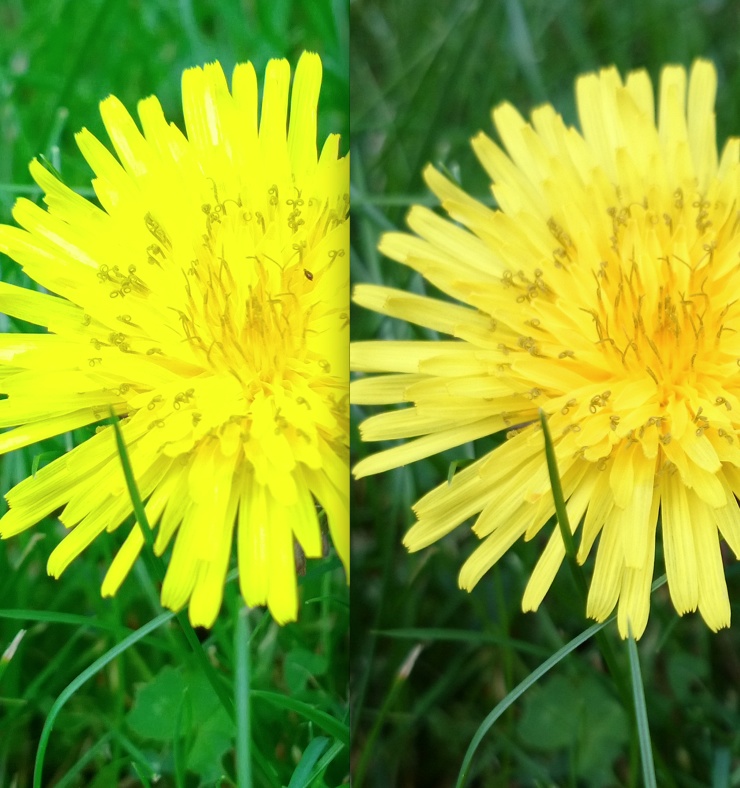
There's not a huge amount between the two photos, but I'd give the win to the Z1 overall - the flower wasn't in the sun, so the flower and grass colours are more accurate on Sony's camera, plus there's better handling of detail and contrast within the flower.
Score: Lumia 1020: 7 pts; Xperia Z1: 9 pts
__________
Test 6: Full sun, zoomed details
Sometimes, it's just nice to use part of the PureView zoom, getting closer without giving in to noise completely. I used about 60% zoom on the 1020 and most of it on the Z1. Here's the full scene, shot in the full sun with oh so colourful subject:

Original images from the Lumia 1020 and Xperia Z1
As ever, let's crop in to central detail to see the sort of quality being delivered by each camera phone. The Lumia 1020 crop is on the left, the Z1 on the right:
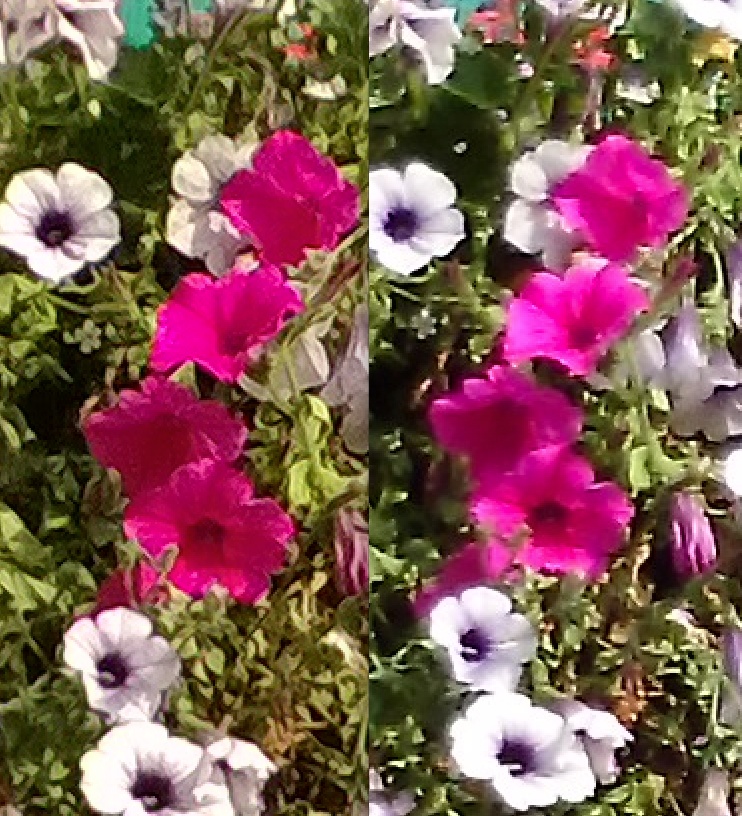
The extra headroom in the Nokia Lumia zoom/oversampling really shows here - ignore the flowers and look at the leaves and plant structure behind - there are artefacts and sharpened approximations aplenty in the Z1's photo, while the Lumia 1020 manages to keep everything looking natural and realistic.
Score: Lumia 1020: 9 pts; Xperia Z1: 7 pts
__________
Test 7: Low light, after dusk, landscape
Ah, now we're starting to push the envelope in terms of light handling. In reality, to my eyes, the scene was much darker than the rendition below. So ignore the fact that both phones make the scene look like it's daylight! Maybe I should mark both down for that? You can tell it's actually dark by the streetlight.
Note that I used the Z1 in 'Manual' mode here, not to change a setting but simply because I took the shot in both modes and the 'Superior auto' one ended up blurred through hand shake. No OIS, you see....!
Here's the full scene:
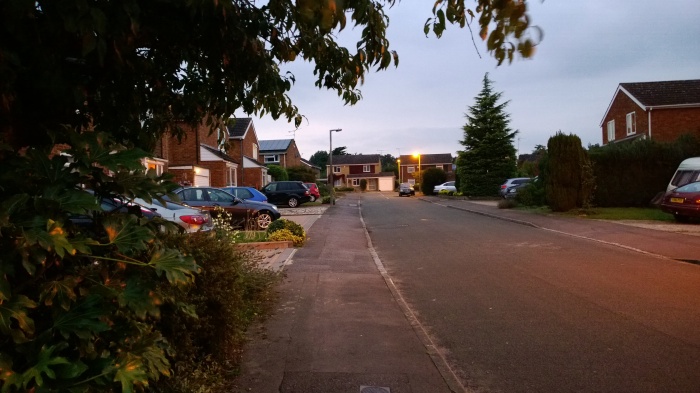
Original images from the Lumia 1020 and Xperia Z1
As ever, let's crop in to central detail to see the sort of quality being delivered by each camera phone. The Lumia 1020 crop is on the left, the Z1 on the right:

Again the Lumia 1020 is stretching its legs here, with far less digital noise and crisper details. The larger sensor and the OIS make a significant difference, as you can see. In particular, I was appalled (not for the first time) at both the severity and character of the noise in the Z1's photos in low light.
Score: Lumia 1020: 8 pts; Xperia Z1: 5 pts
__________
Test 8: Extreme low light, macro
Low light again, but this time right up close, indoors. Here's the full scene:

Original images from the Lumia 1020 and Xperia Z1
As ever, let's crop in to central detail to see the sort of quality being delivered by each camera phone. The Lumia 1020 crop is on the left, the Z1 on the right:
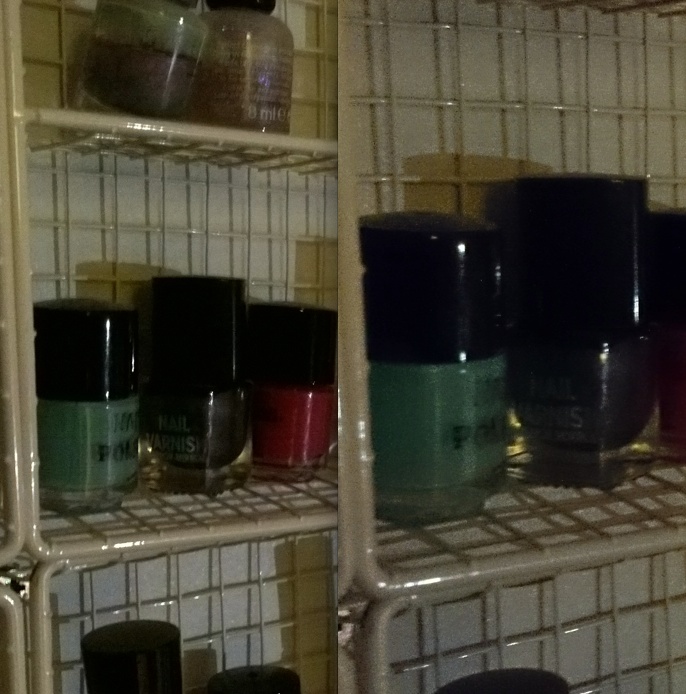
The Z1 did better than I thought it would here, that f/2.0 aperture made sure that some of the room's weak ambient light kept the noise in check. But, despite a lower output resolution, the Lumia 1020's photo has crisper details and far less noise.
Score: Lumia 1020: 9 pts; Xperia Z1: 7 pts
__________
Test 9: Dark room, flash allowed
The same (colourful) nail varnish rack, but this time with all room lighting turned off and taken at 1 metre distance, floodlit by each phone camera's flash. Here's the full scene:

Original images from the Lumia 1020 and Xperia Z1
As ever, let's crop in to central detail to see the sort of quality being delivered by each camera phone. The Lumia 1020 crop is on the left, the Z1 on the right:

Regular readers will know that, in camera phone comparisons, light is king. And Xenon trumps LED on most occasions. The detail and colours in the Lumia 1020 shot, in a pitch dark room, are extraordinary, with the finest details on the labels clearly visible. In contrast, the noise and uncertainty in the Z1 photo, caused by the weak LED flash and noisy sensor, make the photo unpleasant to view up-close and the labels hard to read.
Score: Lumia 1020: 10 pts; Xperia Z1: 6 pts
__________
Test 10: Low light, mocked up party shot
What comparison test would be complete without my trademark party/event mock-up? A dimly lit scene (one central 60W room light), a deliberately moving subject (I try hard to mimic the same movement during each capture) and snapping the scene at around 1.5 metres, is typical of the average pub, event, disco or party photo.
Here's the full scene:

Original images from the Lumia 1020 and Xperia Z1
As ever, let's crop in to central detail to see the sort of quality being delivered by each camera phone. The Lumia 1020 crop is on top, the Z1 on the bottom:

The Lumia 1020 does a great job of preserving the original colour from the scene, despite the use of Xenon flash, which often 'whites' things out. The shot isn't perfectly crisp (watch for an tutorial on getting this to 100%), but it's darned good. The Xperia Z1 produces a typical LED-lit 'people in low light' shot, as evidenced by hundred of millions of photos every day around the planet. Blurry rubbish - you cannot photograph people in a casual setting properly in low light using LED flash. Rant over. Again.
Score: Lumia 1020: 9 pts; Xperia Z1: 4 pts
__________
Verdict
Adding up the scores (partly for fun) gives us the Nokia Lumia 1020 beating the Sony Xperia Z1 by 84 points to 67, quite a margin of victory, although this doesn't tell the whole story.
As you'll see from the order of the test photos, the Z1 stays very close to the 1020 as long as there's enough light around. However, once the light levels drop, whether outdoors or indoors, the Lumia 1020's much larger sensor, its higher native resolution and more advanced oversampling, plus the use of OIS to keep away any hand shake effects and a proper Xenon flash, all play a part in keeping Nokia's device well ahead of the competition.
Is the Z1 the best Android camera phone at the moment? Probably. I'd place it slightly ahead of the Samsung Galaxy S4 overall, and possibly some way ahead once Sony has managed to improve its image processing algorithms. The Samsung Galaxy S4 Zoom would give the 1020 a far closer race, thanks to OIS, Xenon and optical zoom, but that device comes with a huge size penalty, of course, and can't be considered a mainstream smartphone.
It's good to see manufacturers starting to learn lessons from Nokia's imaging innovations, but here a natively noisy sensor and a weedy LED flash really let the Xperia Z1 down. Roll on the Z1 with Xenon and second generation Sony internals?
The Nokia Lumia 1020 remains, then, at the pinnacle of phone imaging as we head towards the end of 2013. Look to Mobile World Congress 2014 for anything which can come close to besting it - and even then I suspect that the challenge will come from Nokia's own engineers, albeit wearing shiny new Microsoft badges....
